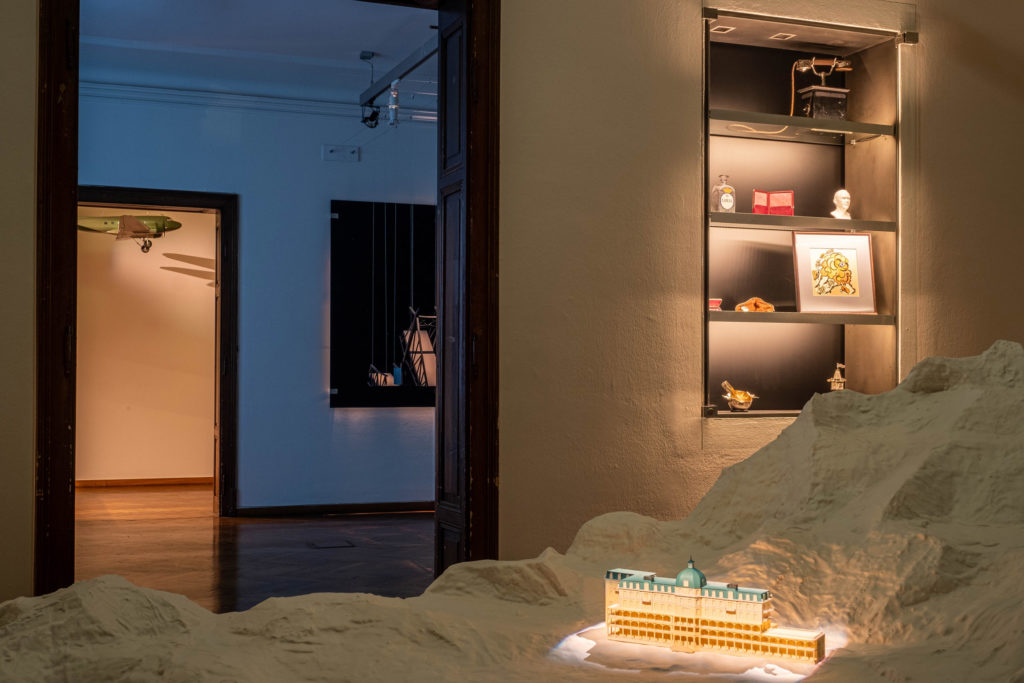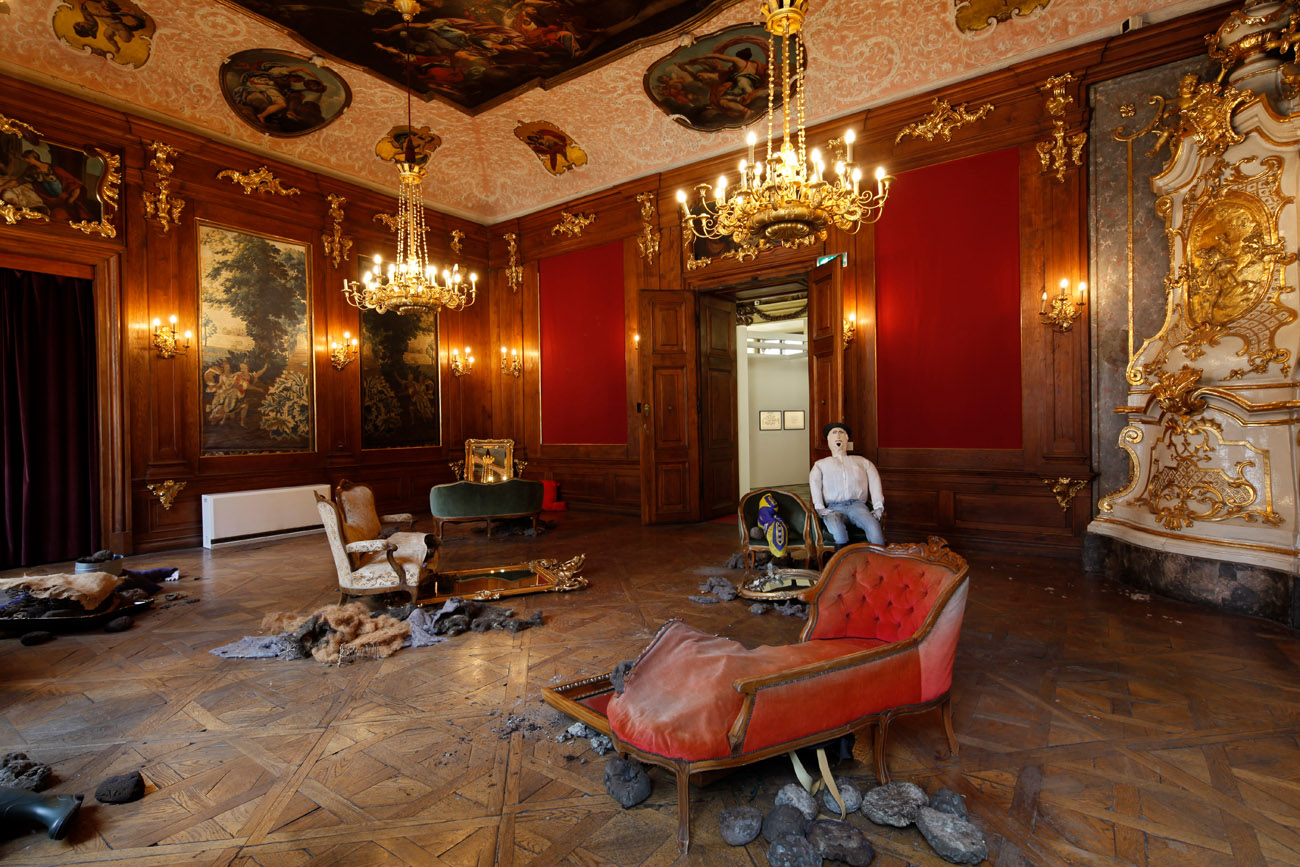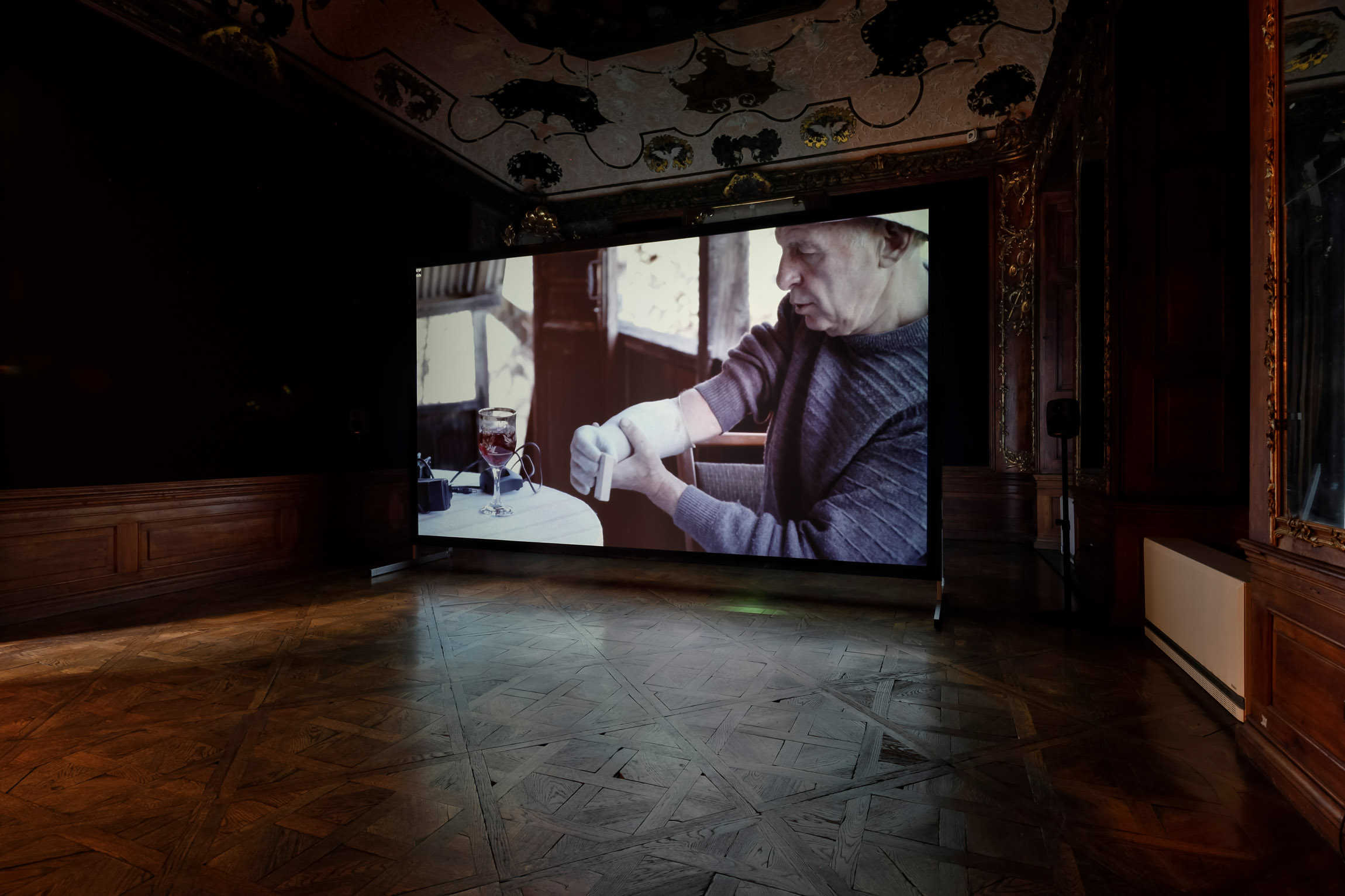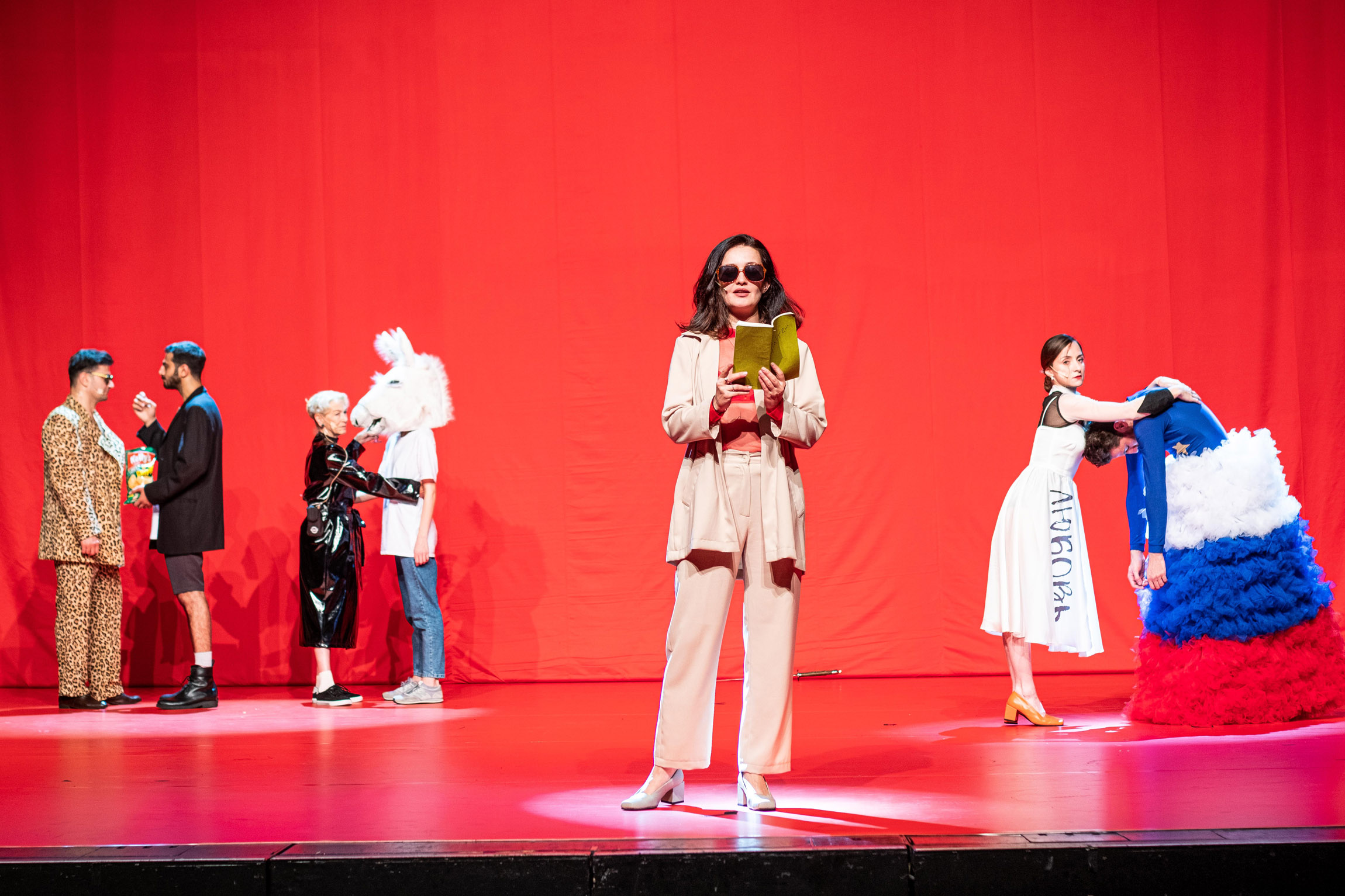Are We Doomed to Suffer Discourse Over Revolution?
Steirischer Herbst 2019: The Grand Hotel Abyss, Graz, Austria, September 19 – October 13, 2019
This year’s iteration of Steirischer Herbst —the annual arts-and-theater festival held in Graz since 1968—took its title from György Lukács’s metaphor the “Grand Hotel Abyss.” Lukács, the Hungarian Marxist philosopher, aesthetician and literary critic, used the term pejoratively. The title in its original usage was aimed at the Frankfurt School’s inclination for theory over action during the interwar period. According to Lukács, the likes of Theodor Adorno, Herbert Marcuse, and Jürgen Habermas represented an intellectually decadent elite locked in a hotel only to be smashed by the encroachment of fascism and the Nazi party. The parallel to interwar period anxiety seems no less weighty today and was the contextual frame of the festival, a project full of anxiety about its own hedonistic predilections.
The metaphor of the Grand Hotel Abyss is a simple one: are we lounging in the lap of luxury while the West is on fire? Touring around Graz, Austria’s second largest city surrounded by sumptuous apple orchards rich in autumnal return, was like being a guest in an extravagant hotel. However unlike a hotel, the “hallways” in Graz tend to bend with the River Mur running through some of the most beautiful baroque architecture in Europe. Despite the festival’s sleek visual identity by Grupe Ee, the Ljubljana-based design collective whose bright green neoclassical presence was found on billboards, buses and posters across the city, most of the works at Steirischer Herbst could have gone unnoticed. Movement across the festival’s twenty-nine venues can be imagined as a pleasant walk through baroque palaces, modern Kunsthalles, hotel lobbies, theaters, and converted store fronts, where one encountered installations and time-based works by more than thirty international artists and collectives that became the occupants of a kind of deranged hotel.
Director and Chief Curator Eketarina Degot’s opening address announced an invitation that harkened the audience to the political uncertainty outside of her curated hotel: “What we are inviting you to is an experience of joie de vivre, of exquisite aesthetic culinary and wellness pleasures, only increased by the feeling—the frisson—that there is a menace of catastrophe out there.” The beckoning of the audience to rapturous genuss (German for coetaneous pleasure and consumption) on the one hand, while asking for acknowledgement of the detriment of overconsumption on the other, made the decadence of the festival slightly unnerving.

Ekaterina Degot and David Riff in collaboration with Livia Páldi, The Life and Adventures of GL, installation, 2019. Literaturhaus Graz. Photograph by Mathias Völzke.
Degot seemed to relish in Graz’s Renaissance setting to bring life to Lukács’s central metaphor. While it is difficult to know if this year’s festival fully adopted Lukács’s ethical turn away from the intellectual left, the canonization of Lukács in installations such as The Adventures of GL provided a clue. Conceived by Degot and Co-curator David Riff, the installation displayed an array of Lukács-related ephemera and knick-knacks, including a Wes Anderson-like model of the Grand Budapest Hotel in miniature. If Lukács was rattled by the interwar period and asked whether we are doomed to suffer discourse over revolution, the Grand Hotel Abyss asked a similar question but with an off-handedness that was often difficult to place.

Oscar Murillo, Social Cataracts, installation, 2019. Palais Attems, Graz. Photograph by Liz Eve.
In addition to Lukács, the festival literature also mentioned Thomas Mann’s novel The Magic Mountain (1924) as a source of inspiration for the creative concept. In The Magic Mountain, a luxurious Swiss sanatorium in Davos sets the scene for the exploration of characters as microcosms of European society. Like Mann’s novel, the festival juxtaposed works of art with themes of decay and luxurious backdrops to emphasize pathologies within society. For example, Colombian artist Oscar Murillo’s installation Social Cataracts (2019) sited in the refined interior of the Palace Attems—one of the greatest masterpieces of Austrian baroque architecture—was a gross mismatch to Murillo’s scarecrowlike effigies, contorted and dropped carelessly on the floor or hung over disemboweled period sofas. Murillo’s work was a good example of the provocative scenographic moments of the festival, where the disparity between the setting and the art on display encouraged deeper contemplation of Degot’s curatorial themes. How then did the splendor of the Grand Hotel Abyss serve as a metaphoric site to critically discuss the culture of pleasure today?

Giorgi Gago Gagoshidze, The Invisible Hand of My Father, 2018. Film, installation view, Palais Attems, Graz. Photograph by Liz Eve.
Contributions by artists from Central and Eastern Europe demanded that the viewer consider personal comfort and luxury against the reality of troubled times outside the Grand Hotel Abyss. A highlight of the festival was the film The Invisible Hand of My Father (2018) by Berlin-based Georgian artist Giorgi Gago Gagoshidze. Shown at the Palais Attems in the flanking enfilade to Murillo’s Social Cataracts, Gagoshidze’s film with its DIY voiceovers and interviews with his father offered an alluring work of realism and was a dignified exploration of the economic conditions ravaging European families. The film’s juxtaposition with Murillo’s languid mannequins tossed about the room next door revealed a palpable distinction in the level of care and craftsmanship that went into each work, while engaging the theme of the Grand Hotel Abyss flawlessly.
Gagoshidze’s film tells the story of his father’s search for work in Europe following the fall of the Iron Curtain, and after the loss of his arm on a jobsite in Portugal. The film’s use of 3-D animation and drones came as an afterthought to the larger context of the father’s phantom limb providing for the family after the 2008 financial crisis. The sweetness of the father, the pleasure of his retirement garden back home, and the tragic irony of his escape from market labor was a bittersweet assessment of Adam Smith’s “invisible hand of the market,” and a reminder that leisure has its sociopolitical costs.

Artur Żmijewski, Plan B, 2019. Installation, Girardigasse 8, Graz. Photograph by Mathias Völzke.
Where Gagoshidze’s work addresses the personal, Polish artist Artur Żmijewski’s installation Plan B (2019) works at social engagement via a contemplation of anonymity. Żmijewski’s use of a vacant storefront in downtown Graz unfolded in an unexpected way, with the installation’s facade emulating a seamstress’s shop. Once inside, ushers guided viewers to a hole in the rear of the shop, through which one discovered an installation inspired by prepper projects and walking-dead scenarios, and bunkers used for concealing those fleeing persecution. In his manifesto, Applied Social Arts (2007), Żmijewski criticizes art’s exaltation, alienation, and wasted potential. This installation forced the public to crouch down and squeeze through the floor to enter it. Beyond the 2×4 concentration camps bunks, one witnessed the terrible sight of a smutty toilet used by potentially dozens of men, women and children in hiding. The act of crawling into the exhibition dramatized the work’s theme of personal escape, either from or to the world of luxury services and goods outside the installation.

Nedko Solakov, Lost Cold War Spies, 2019. 23 figurines in 6 hotel lobbies and bars, installation, Graz. Photograph by Liz Eve.
Bulgarian artist Nedko Solakov’s installation Lost Cold War Spies (2019) consisted of twenty-three spy figurines placed within six hotel lobbies in Graz. Solakov, the facetious Sophia-based interdisciplinary artist, has for the last forty years made art that relies on narrative. In attempting to find Solakov’s little spies the public had to walk from one marbled foyer to the next. The search brought one’s gaze towards the hotels’ molded frescos, while concierges peeked at viewers suspiciously. In this game of hide-and-seek, Solakov inverted the relationship between the art and the viewer. Entering the lobby of a hotel to engage with Solakov’s handmade figurines made one feel as if they were being watched by both the hotel staff and the art. This feverish kind of John le Carré scenario was an intentional nod to the time when Austria was divided into four allied sectors, with Graz serving as headquarters for the British occupation. (Interestingly, le Carré himself was stationed in Graz.) With a dose of humor and irony, Solokov’s figurines offered an amusing link between artistic imagination and local history that exposed the dangerous comforts addressed throughout the festival.

Keti Chukhrov / Guram Matskhonashvili, Global Congress of Post-Prostitution, 2019. Performance, Orpheum Graz. Photograph Mathias Völzke.
While the main focus of this year’s Steirischer Herbst seemed to be about socially engaged visual art, it must be remembered that it is Austria’s largest annual festival of art and theater. Graz should have been shaken by the Russian cultural theorist Keti Chukhrov’s play Global Congress of Post-Prostitution (2019). However, Chukhrov lacked a script that could bridge major philosophical positions with a believable physical presence meant to express it on a stage. Instead, what ought to have been a daring critique of what Degot called in her opening address the West’s “dictatorship of pleasure,” Chukhrov’s script relied too heavily on post-human logic to take up sex work that is still by and large carried out by humans who must face the consequences of real interaction. The play, staged by theater director Guram Matskhonasvili, tells the story of a group of social scientists, curators, and sex workers who travel to Zugdidi, Georgia, to participate in a congress on “post-prostitutive sexual-intellectual practices.” The alienation between theory and practice in this play seems like a master class in being well read, but missing was the wisdom to say anything about either Marxism or prostitution – presumably the two objects of the play’s satirical delivery. Perhaps this is the point. Chukhrov exposes the arrogance of performance art concerned more with philosophical testing of discourse rather than serious concern with issues on the doorstep of the Grand Hotel Abyss. The production’s frivolous execution of monologues on topics like “fluffers”–those whose job it is to prepare another person´s erection before sex–is lost in its own discursive play. When Chukhrov declares that “the cock and pussy are not organs, they are ideas,” what should have been a moment of revelation becomes an attempted satirical dig; at what, we are unclear since the script was virtually unperformable for many of the actors who struggled with the English.

Jasmina Cibic, The Gift—Act I, 2019. Video, installation view, Künstlerhaus, Halle für Kunst & Medien, Graz. Photograph by Mathias Völzke.
Where Chukhrov attempts to instrumentalize theory for entertainment’s sake, Slovenian artist Jasmina Cibic’s twenty-minute, three-channel film The Gift–Act I (2019) used theory as a tool to think about important cultural legacies in Graz, asking how governments instrumentalize culture for the formation of national identity and maintenance of hegemony. Her film is a poetic study of cultural gifts with reference to the very building it was exhibited in. In Graz there is a rumor that the Künstlerhaus is a “gift” from the British occupation forces. This is an unsubstantiated rumor but provides much speculation for the artist’s elegant rumination on the aesthetic permutations within art and architecture as “soft power.” In her film, statecraft strategies used to achieve the ultimate display of dominance are questioned. How are state interests and rhetoric deployed through art and architecture as a Trojan Horse to shape public perception? Cibic’s work suggests that state-funded art initiatives like Steirischer Herbst do indeed have the power to shape public opinion.
So what was the true power of this year’s festival to make meaningful impact upon the publics who viewed it? With its theme the Grand Hotel Abyss, it seemed to offer a critical approach to the decadence of art as a luxury commodity. However, such decadence is not what ultimately came through as one experienced the various installations and distinctive performances in Graz. While the Grand Hotel Abyss presented art and artists as part of a larger conversation on a fragile present, in terms of the future, it offered two opposing logics. The first sees art as a tool to be harnessed for political ends; the second insists on the aesthetic as a place for play free from political consequence.
As a Western city situated beside Eastern Europe and other post-Soviet countries, Graz is, according to Degot, an exceptional location to investigate some of the darker sides of Western culture from Eastern perspectives. Steirischer Herbst’s exploration of the passions guiding popular narratives of wellness and pleasure provided space for a nuanced critique. The critique was an amusing one. The curators daringly placed aim at the state sponsors of their festival and at the artistic world as a wielder of luxury goods. As such, the Grand Hotel Abyss encouraged its guests to indulge, and most of the works were festive, in their own way. The placement of counterpositions that questioned the logic of a market and a society dependent on increased consumption was demanding, but never didactic. Critique of the changing political landscape in Europe often became part of what was served at the Grand Hotel Abyss. Degot’s ability to perceptively frame Western pathologies through Central-Eastern European impulses were at their best when the carnivalesque “joie de vivre of exquisite aesthetic culinary and wellness pleasures” were tempered with more sober works.





